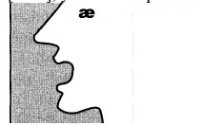标准美语发音的13个秘诀 CD 3 Track 5(在线收听)
Chapter 3. Cat? Caught? Cut? CD 3 Track 5
After laying our foundation with intonation and liaisons, here we finally begin to refine your pronunciation! We are now going to work on the differencesbetween [?], [?], and [?], as well as [ō], [ā], and [ē]. Let's start out with the [?] sound.
The [?] Sound
Although not a common sound, [?] is very distinctive to the ear and is typically American. In the practice paragraph in Exercise3-2 this sound occurs fivetimes. As its phonetic symbol indicates, [?] is a combination of [?] + [ε]. To pronounce it, drop your jaw down as if you were going to say [?]; then from thatposition, try to say [ε]. The final sound is nottwo separate vowels, but rather the end result of the combination. It is very close tothe sound that a goat makes: ma-a-aa!
Y Try it a few times now: [?] f [?]
If you find yourself getting too nasal with [?], pinch your nose as you say it. If [k?t] turns into [kε?t], you need to pull the sound out ofyour nose and down into your throat.

图片1
Note As you look for the [?] sound you might think that words like downor soundhave an [?] in them. For this diphthong, try [?] + oh, or [?o]. This way, downwould be written [d?on]. Because it is a combined sound, however, it's not included in the Cat? category. (See Pronunciation Point 4 on page ix).
The Schwa [?] Sound
Last is the schwa [?], the most common sound in American English. When you work on Exercise 3-2, depending on how fast you speak, how smoothly you make liaisons, how strong your intonation is, and how much you relax your sounds, you will find from 50 to 75 schwas. Spelling doesn't help identify it, because itcan appear as any one of the vowels, or a combination of them. It is a neutral vowel sound, uh. It is usually in an unstressed syllable, though it can be stressed as well. Whenever you find a vowel that can be crossed out and its absence wouldn't change the pronunciation of the word, you have probably found a schwa: photography [ph'togr'phy] (the two apostrophes show the location of the neutral vowel sounds). Because it is so common, however, the wrong pronunciation of this one little sound can leave your speech strongly accented, even if you Americanized everything else.
Note Some dictionaries use two different written characters, [?] and but for simplicity, we are only going to use the first one.
Silent or Neutral?
A schwa is neutral, but it is not silent. By comparison, the silent E at the end of a word is a signal for pronunciation, but it isnot pronounced itself: code is [kod]. The E tells you to say an [o]. If you leave the E off, you have cod, [k?d]. The schwa, on the other hand is neutral, but it is an actual sound—uh. For example, you could also write photography as phuh?tah?gruh?fee. Because it's a neutral sound, the schwa doesn't have any distinctive characteristics, yet it is the most common sound in the English language.
To make the [?] sound, put your hand on your diaphragm and push until a grunt escapes. Don't move your jaw, tongue, or lips; just allow the sound to flow past your vocal cords. It should sound like uh.
Once you master this sound, you will have an even easier timewith pronouncing can and can't. In a sentence, can't sounds like [k?n(t)], but can becomes [k?n], unless it is stressed, when it is [k?n], (as we saw in Exercise 1-43 on p. 41). Repeat.
In the vowel chart that follows, the four corners represent the four most extreme positions of the mouth. The center box represents the least extreme position—the neutral schwa. For these four positions, only move your lips and jaw. Your tongue should stay in the same place—with the tip resting behind the bottom teeth.
Vowel Chart
I can do it. [Ik?n do it]
I can't do it. [Ik?n't do it]

图片1
1. To pronounce beat, your lips should be drawn back, but your teeth should be close together.
Your mouth should form the shape of a banana.
2. To pronounce boot, your lips should be fully rounded, and your teeth should be close
together. Your mouth should form the shape of a Cheerio.
3. To pronounce bought, drop your jaw straight down from the boot position. Your mouth
should form the shape of an egg.
4. To pronounce bat, keep your jaw down, pull your lips back, and try to simultaneously say [?]
and [ε]. Your mouth should form the shape of a box.
Note Word-by-word pronunciation will be different than individual sounds within a sentence. That, than, as, at, and, have, had, can, and so on, are [?] sounds when they stand alone, but they are weak words that reduce quickly in speech.